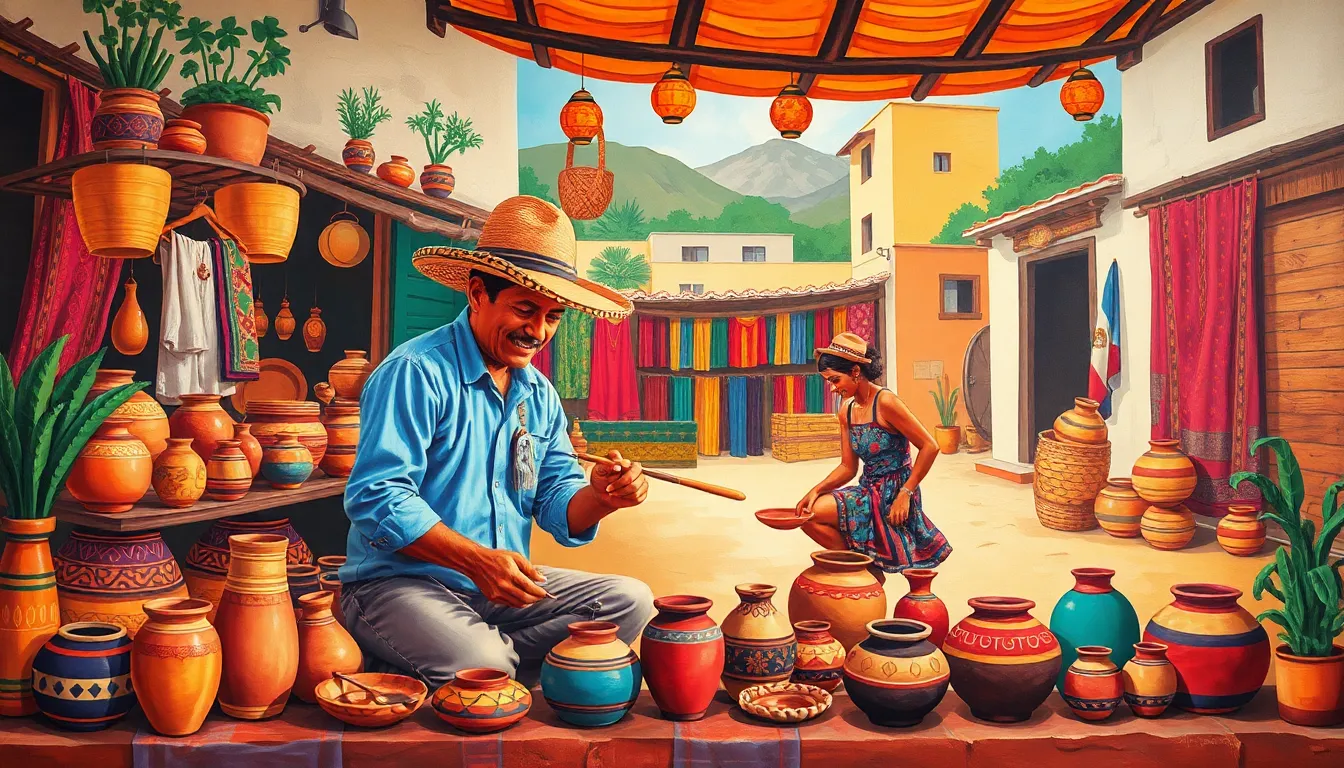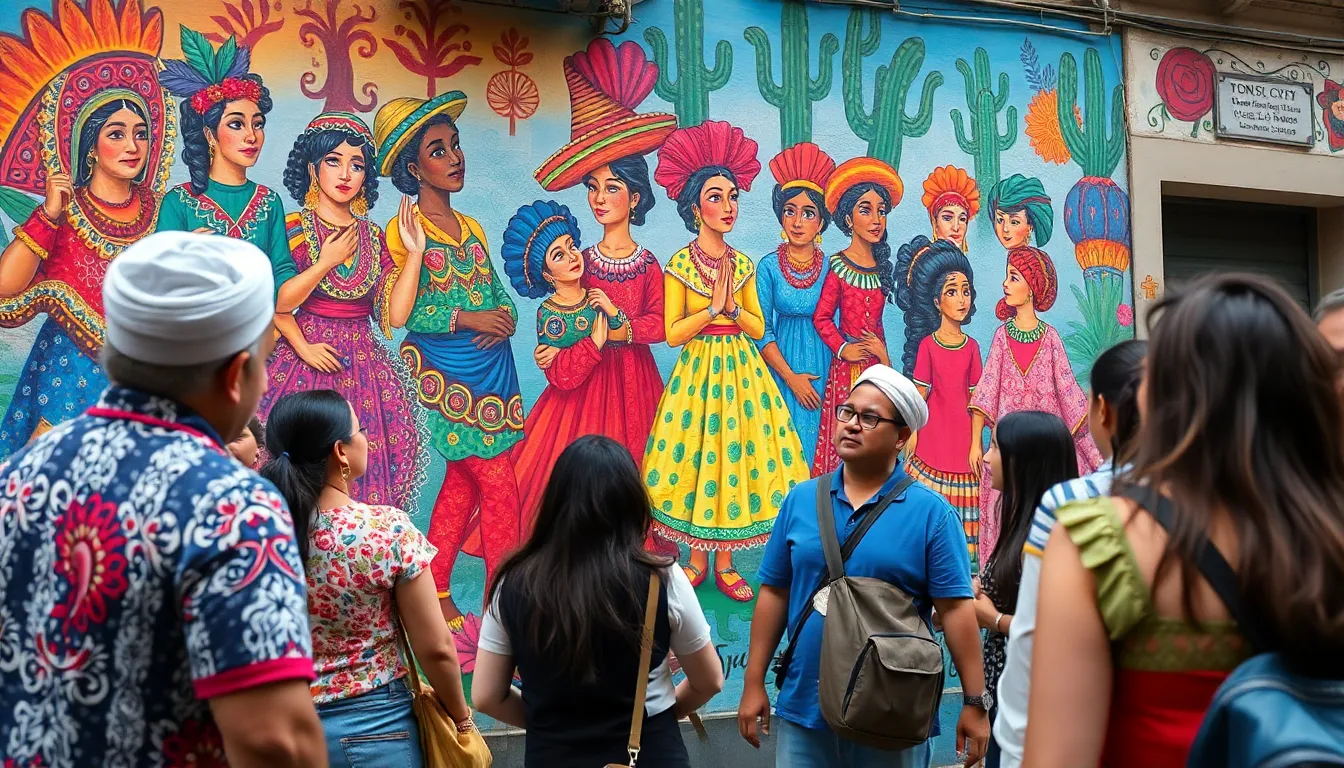Dive into the vibrant world of Mexican art styles, where every brushstroke tells a story and every color dances with life. From the intricate patterns of traditional textiles to the bold murals that adorn city walls, Mexican art is a feast for the eyes and a celebration of culture. If you think art is just for galleries, think again—it’s alive and kicking on every street corner in Mexico!
Mexican Art Styles
Mexican art presents a vast spectrum of styles that reflect the nation’s rich history and cultural diversity. Pre-Hispanic art serves as one foundation, encompassing intricate sculptures, pottery, and murals from civilizations like the Maya and Aztec. This ancient artistry is not just aesthetically pleasing; it contains narratives that encapsulate religious beliefs and societal structures.
Another significant style is folk art, which thrives within local communities. Artists utilize accessible materials to create vibrant textiles, ceramics, and woodcrafts. Each piece often incorporates cultural motifs, showcasing daily life and regional traditions.
Modernist art also plays a vital role in the Mexican art scene. Influenced by global movements, notable figures like Diego Rivera and Frida Kahlo pushed boundaries through their bold styles and thematic depth. Their works address social issues and celebrate Mexican identity, resonating with audiences worldwide.
Contemporary art, emerging in the late 20th century, further diversifies this artistic landscape. Artists experiment with new mediums and conceptual approaches, addressing political and cultural themes relevant today. Muralism experienced a revival, becoming a medium for social commentary in public spaces, symbolizing hope and resistance.
Street art in urban environments has also gained prominence, blending traditional and modern techniques. These vibrant murals transform cityscapes while engaging communities in dialogue about identity and change.
Overall, Mexican art styles capture an evolution that reflects the nation’s identity, history, and ongoing dialogue about culture and society. Each style narrates its unique story while contributing to a collective cultural heritage.
Traditional Mexican Art Styles

Traditional Mexican art styles encompass a wide range of vibrant expressions rooted in rich cultural heritage. Different forms illustrate the country’s diverse history, deeply engaging with themes of identity, tradition, and community.
Folk Art
Folk art represents local traditions through unique crafts like textiles, pottery, and woodwork. Artisans often incorporate vivid colors and intricate designs that tell stories from their communities. Ceramics from regions such as Talavera and Oaxaca showcase skillful techniques passed down through generations. Textiles, woven by hand in places like Chiapas, feature complex patterns that symbolize local customs. Each piece reflects the values and histories of the people, capturing the essence of Mexican life.
Muralism
Muralism emerged as a powerful artistic movement in the early 20th century that aimed to address social issues. Artists like Diego Rivera and David Alfaro Siqueiros focused on large-scale works that portrayed the struggles and triumphs of the Mexican people. Walls served as canvases, bringing art into public spaces and making it accessible to all. Themes of labor, revolution, and indigenous heritage filled these murals, fostering a sense of national identity. This movement not only transformed urban environments but also ignited conversations about culture and social justice.
Contemporary Mexican Art Styles
Contemporary Mexican art styles reflect the country’s evolving cultural landscape and effectively blend tradition with modern influences. Various movements have emerged, each contributing distinct perspectives to the art scene.
Abstract Art
Abstract art in Mexico focuses on shapes, colors, and forms that encourage interpretation beyond realism. Artists like Rufino Tamayo and Juan Soriano explore themes of identity and emotion, creating works that evoke personal experiences. Techniques often incorporate bold colors and dynamic compositions to draw viewers in. Abstract expressionism has gained traction, with artists experimenting in innovative ways that challenge conventional forms. This style resonates particularly in urban galleries where artists showcase their evolution and experimentation.
Street Art
Street art represents a vibrant and accessible form of contemporary expression in Mexico. Particularly prevalent in cities like Mexico City, this art form addresses social issues and cultural identity, often using walls as canvases. Artists such as SCOPE and El Mac transform public spaces into open galleries that speak to both local and global audiences. Sophisticated techniques and murals often incorporate traditional motifs, creating a dialogue between past and present. This dynamic art encourages community engagement and serves as a powerful medium for social commentary, reflecting the ongoing narratives shaping Mexican society.
Influences On Mexican Art Styles
Mexican art styles emerge from a rich tapestry of cultural influences. These influences shape the essence and evolution of the country’s artistic expression.
Pre-Hispanic Influence
Pre-Hispanic art laid the foundation for Mexican creativity. Ancient civilizations like the Maya and Aztec contributed intricate sculptures and murals filled with symbolism. Artifacts from this era reveal deep spiritual and cultural narratives. Distinctive motifs often depict gods, rituals, and daily life, showcasing the profound connection between art and identity. Artists utilized locally sourced materials, reflecting the region’s resources and techniques.
Colonial Influence
Colonial art introduced European styles and themes to Mexican creativity. Spanish colonizers brought new techniques, such as oil painting, and influenced local artisans significantly. This blend of indigenous and European elements led to the emergence of unique Baroque styles. Artists often combined Catholic iconography with native symbols, creating a distinctive visual language. The period also saw the rise of religious art, deeply embedded within the colonial landscape, using churches and monasteries as vital platforms for expression.
Conclusion
Mexican art styles embody a vibrant tapestry of history and culture that continues to evolve. From ancient pre-Hispanic influences to contemporary expressions in street art, each style reflects the diverse narratives of the Mexican people. The interplay of tradition and modernity creates a unique artistic landscape that resonates with both locals and visitors alike.
By engaging with these art forms, individuals can gain a deeper appreciation for the stories they tell and the cultural significance they hold. As Mexican art continues to thrive in various mediums, it remains a powerful vehicle for social commentary and community connection, ensuring its place in the heart of both Mexico and the world.

